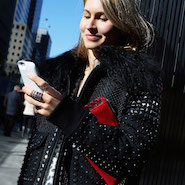- About
- Subscribe Now
- New York,
January 27, 2015

 Reaching the luxury consumer requires a mobile-optimized approach
Reaching the luxury consumer requires a mobile-optimized approach
Luxury brands improved their digital performance by 8 percent over the last quarter, according to a new report by ContactLab and Exane BNP Paribas.
Generally, brands prioritized boosting their digital customer experience rather than their strategic reach, implementing new technology instead of focusing on market expansion via digital channels. Brands are currently only reaching 50 percent of their full potential for digital customer experience, a gap that many are looking to close.
"What we perceive is that overall all the luxury companies are moving with precision quickly, considering the short amount of time from the two measurements we made," said Stefano Lena, vice president of sales, ContactLab, Milan. "They are moving very quickly toward digitalization and a strong digital positioning.
"Maybe you will not see a constant increase of every single brand, but now I am expecting that followers will now move faster to try to reach the first movers."
“The Digital Competitive Map: January 2015 - The Race is on!” ranks 28 brands in the apparel and accessories and jewelry sectors in digital experience and strategic reach using qualitative data.
Moving on up
Most of the brands studied raised their digital standings, with Gucci, Cartier, Bulgari, Saint Laurent, Brunello Cucinelli and Michael Kors making the most progress. Michael Kors switched its digital operations from Neiman Marcus to in-house, showing the growing investment by brands in their own online environments.
Screenshot of Michael Kors' ecommerce site
Burberry, while retaining its number one ranking in strategic reach, fell behind competitors in digital customer experience, landing eighth. Instead, top marks went to Gucci, Louis Vuitton and Cartier.
Other reports have similarly placed Gucci ahead of Burberry in digital. Following three years at the top of L2’s digital leaderboard, Burberry lost its rank to Gucci and Coach, since its omnichannel efforts could not make up for an outdated Web site infrastructure. Brands need to ensure that they are maintaining their digital flagships as they expand their digital presence (see story).
Screenshot of Gucci's ecommerce site
Growth in strategic reach needs to happen on an organizational level, requiring cooperation from senior management. Therefore, it is more difficult to implement than pure digital growth, which only relies on investment.
Over the past four months, seven of the 28 brands in the study have revamped their Web site design, including Valentino, Balenciaga and Bulgari. Prada altered the look of its mostly-black site, leading instead with imagery and hiding its extensive menu behind a button.
Screenshot of Prada's Web site
Not studied in the report, Balmain also overhauled its digital presence with a new fully-responsive Web site on an enhanced ecommerce platform during the same period (see story).
Showing the continued importance of the Brazilian consumer, four study brands, including Zegna, Bulgari and Hermès, added a Portuguese option for their Web sites.
Mobile accessibility was also a priority, with five brands releasing mobile versions of their sites. One of these brands was Loro Piana, which expanded its mobile commerce beyond its iOS application with a mobile-optimized Web site, allowing consumers to shop on a wider range of devices (see story).
Loro Piana mobile site
ContactLab’s data from email campaigns sent for clients has shown that 40 percent of messages are opened on mobile devices, a statistic that is higher for luxury brands.
Recognizing the importance of mobile, 26 of the 28 brands now offer a mobile site.
"Luxury customers are mobile by definition," Mr. Lena said. "Every contact connection you make through digital needs to be designed through mobile. It’s a no-brainer."
Crossing the channel
Cross-channel shopping experiences continue to be a rarity among luxury brands, with brands studied only reaching 42 percent of their full potential for this criteria. However, some brands are taking a step in that direction with additions to their ecommerce sites.
Michael Kors and Brunello Cucinelli now offer in-store returns for online purchases, and Gucci, Ralph Lauren and Balenciaga were among the labels that added an in-store availability search to product pages, a function that has become a standard among U.S. brands.
Screenshot of Balenciaga's ecommerce site
Ordering online in-store and picking up items purchased online in-store are still uncommon. Of the study brands, only Zegna allows for ecommerce ordering within its stores.
While almost half of consumers show a preference for shopping online, only 29 percent actually made their last purchase via ecommerce, according to a new report by IBM.
There is a growing preference for online shopping, but it has not completely displaced the role of the bricks-and-morter store. Instead, retailers should be thinking of ways to bring aspects of the digital experience in-store to more fully cater to consumer expectations (see story).
Brands should make sure their digital customer experience is in order in one market before expanding into new territory, according to Mr. Lena. Consumers expect products to be available and delivered in a timely fashion, and if a brand cannot deliver on that, then he says, it is better not to start to enter a new region.
The number one priority should be connecting all communications between channels, so that the consumer experience is unified.
"[Brands] need to define a digital strategy consistent with a physical strategy and positioning," Mr. Lena said. "They should offer the same features on both sides, physical and digital and reduce the gap of the value proposition between the two experiences.
"Think across channels, think of the digital customer experience as part of an overall experience that you provide to customers."
Final Take
Sarah Jones, editorial assistant on Luxury Daily, New York
Share your thoughts. Click here